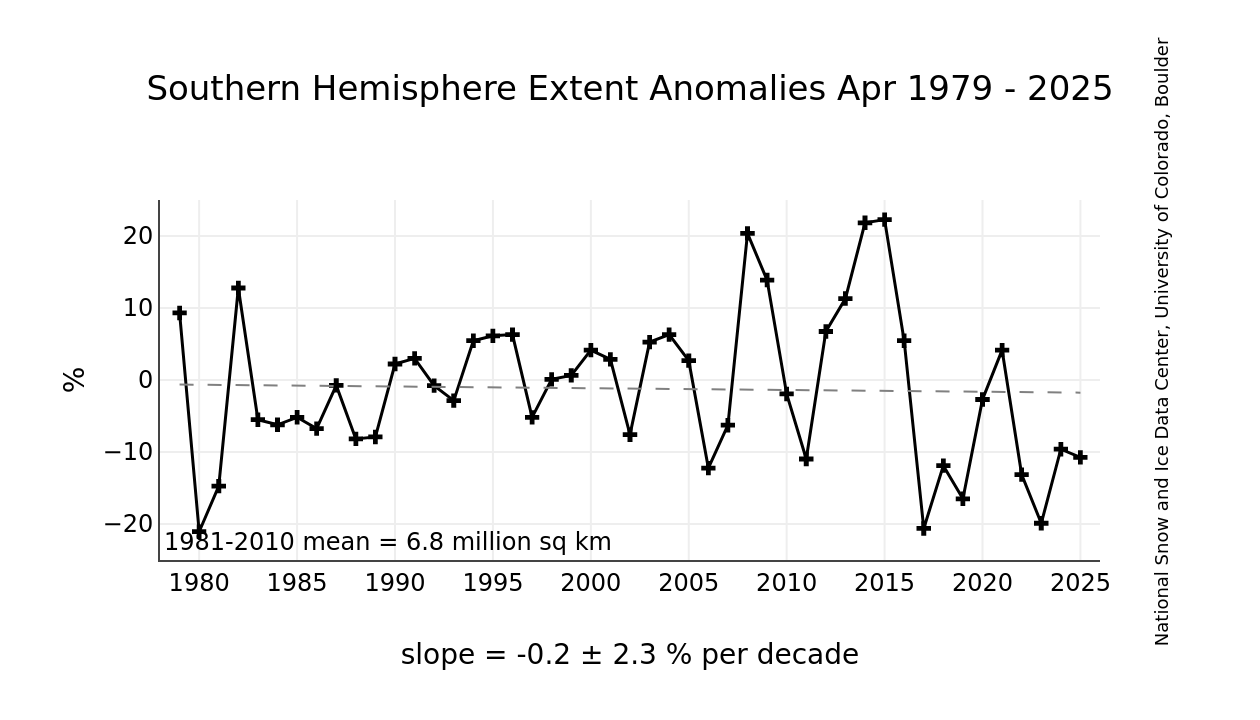Chapter 12: What’s Happening to the Antarctic?
The South Pole is like a planetary air conditioner. Its land area is about the same as the sea area in the Arctic. But Antarctic sea ice is expanding, not shrinking, a strange anomaly given the forcing of global warming. Or at least it was when Wadhams wrote in 2016. Here is a chart from
https://nsidc.org/data/seaice_index showing the previous increase in the annual maximum followed by sudden collapse until 2019, with the 2020 figure showing a tiny increase.

Wadhams explains how with Antarctica surrounding by the heaving seas of the Southern Ocean, its annual sea ice growth cycle follows very different methods compared to the North Pole. He went on a study in 1986 which found that the sea ice frontier grows as a dense suspension called frazil, which then accretes into pancakes, only becoming fully solid hundreds of kilometres in from the edge of the ice, forming roughly jumbled shapes. The sea ice remains thin enough for light to penetrate enabling algae to grow underneath through the winter, and is still very little understood. Meanwhile, the ocean dumps a lot more snow on top of the ice than in the Arctic, which pushes the ice surface under the sea surface, creating a wet slush.
The growth of Antarctic sea ice area is a conundrum for climate models, given that polar air temperature has increased rapidly over the last fifty years, up to 3°C at one site. One explanation is that higher wind speeds and bigger waves caused by warming are spreading the ice out, suggesting the growth in extent is a strictly limited anomaly.
Overall, Wadhams says Antarctica’s continental glacial ice was shrinking by about eighty cubic kilometres per year, compared to at least 300 km3 from Greenland. A more recent
source puts the Greenland loss at 500 km3 per year, close to double Wadhams' figure, and four times faster than in 2003, with the ice is sliding into the ocean on its bedrock due to the surface melt lubricating the whole ice mass.
At both North and South Poles, ice sheets could rapidly disintegrate as warmer water melts them from underneath. Wadhams concludes this chapter by observing that the Arctic is the driver and the Antarctic is the trailer in the global warming road race to oblivion.



 Wadhams explains how with Antarctica surrounding by the heaving seas of the Southern Ocean, its annual sea ice growth cycle follows very different methods compared to the North Pole. He went on a study in 1986 which found that the sea ice frontier grows as a dense suspension called frazil, which then accretes into pancakes, only becoming fully solid hundreds of kilometres in from the edge of the ice, forming roughly jumbled shapes. The sea ice remains thin enough for light to penetrate enabling algae to grow underneath through the winter, and is still very little understood. Meanwhile, the ocean dumps a lot more snow on top of the ice than in the Arctic, which pushes the ice surface under the sea surface, creating a wet slush.
Wadhams explains how with Antarctica surrounding by the heaving seas of the Southern Ocean, its annual sea ice growth cycle follows very different methods compared to the North Pole. He went on a study in 1986 which found that the sea ice frontier grows as a dense suspension called frazil, which then accretes into pancakes, only becoming fully solid hundreds of kilometres in from the edge of the ice, forming roughly jumbled shapes. The sea ice remains thin enough for light to penetrate enabling algae to grow underneath through the winter, and is still very little understood. Meanwhile, the ocean dumps a lot more snow on top of the ice than in the Arctic, which pushes the ice surface under the sea surface, creating a wet slush.